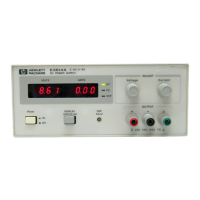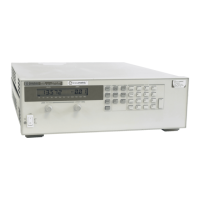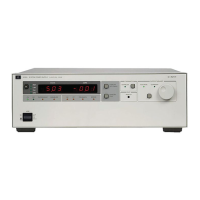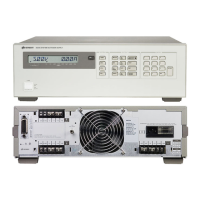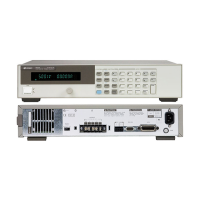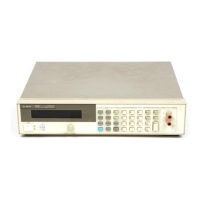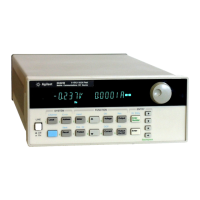88 Principles of Operation
With the CV mode in effect, the CV loop will regulate the output voltage. The CV control circuit compares the programmed
voltage signal CVPROG (0 to -10 V range) with the output voltage monitor signal VMON. The VMON signal is in the 0 to
+10 V range which corresponds to the zero to full-scale output voltage range of the supply. If the output voltage exceeds the
programmed voltage, the OUTPUT CONTROL signal goes low, causing the output transistor to conduct less and decrease
the output voltage.
Conversely, if the output voltage is less than the programmed voltage, the OUTPUT CONTROL signal goes high, causing
the output transistors to conduct more and increase the output voltage. Depending upon the position of the SENSE switch,
the output voltage is either monitored at the supply’s output terminals (local), or at the load (remote), using the +S and -S
terminals with remote sense leads connected to the load. If the output voltage goes higher than the programmed value, the
downprogramming stage is turned on.
Note that an external signal VP can be used to program the output voltage in the CV mode. A 0 to -5 V externally applied
signal produces a proportional output voltage from zero to full scale. VP is summed with the CVPROG and VMON signals.
With the CC mode in effect, the CC loop regulates the output current. The CC control circuit compares the programmed
current signal CCPROG (0 to -10 V), with the output current monitor signal (IMON).
The IMON signal is produced by measuring the voltage drop across current monitoring resistor R657 (RMON). The IMON
signal is in the 0 to +10 V range, which corresponds to the zero to full-scale output current range. If the output current
exceeds the programmed value, the OUTPUT CONTROL goes low, causing the output transistors to conduct less and thus
decrease the output current.
Conversely, if the output current is less than the programmed value, the OUTPUT CONTROL signal goes high, causing the
output transistors to conduct more and increase the output current. Note that the external signal IP can be used to program
the output current in the CC mode. A 0 to -5 V externally applied signal produces a proportional output current from zero to
full scale. IP is summed with the CCPROG and IMON signals. When the power supply is programmed down (in the CV or
CC mode), the CV/CC control circuit causes the DP CONTROL signal to go low, which in turn causes the
downprogramming transistors to conduct current away from the load and speed up downprogramming.
The secondary bias supply generates the +5 V and ±15 V bias voltages for the secondary interface circuits and for the
CV/CC control circuits. The ±15 V is also sent to the output stage bias/shutdown circuit.
When power is initially applied, a secondary power clear signal (SPCLR) is generated to initialize the secondary interface
circuits. The output stage bias/shutdown circuit holds off the output until the secondary bias voltages have time to stabilize.
After a delay of 40 ms, the ±15 ISUP signal is generated, and the GATED ±15 V bias is enabled, allowing the output
regulator stages to be turned on.
During operation, the output stage bias/shutdown circuit will turn off the GATED ±15 V bias voltages, and will shut down
the output if any of the following occur:
• The output is programmed off.
• An over voltage condition is detected (OVSCR signal is received).
• The line voltage falls below 90 volts (approximately).
• The INHIBIT signal is received.
• A secondary bias supply failure occurs.
The SCR control circuit is enabled when the ±15 ISUP signal is received. When an over voltage condition occurs (OVSCR
signal is generated as described previously), the SCR control circuit generates the OV signal, which in turn fires the SCR,
thus shorting the output of the supply.
The fan speed control circuit, included in the functional circuit block with the secondary bias supply, provides the DC
voltage to operate the cooling fan. The FAN PWM (pulse width modulated) signal from the secondary microprocessor
varies this voltage according to the ambient temperature and the output current of the supply.
